Hello readers! Let’s step into the world where tradition meets style—through the delicate beauty of filigree anklets. If you have ever admired jewelry that looks like lace made of silver or gold, you have already glimpsed the magic of filigree.
This art form, with its fine wires twisted and curled into intricate designs, has been a part of Indian heritage for centuries.
But anklets are not just ornaments; they are storytellers. In many cultures, they symbolize elegance, grace, and even good fortune. And when filigree art meets anklets, the result is something extraordinary—lightweight, detailed, and utterly captivating.
History and Evolution of Filigree Anklets
Core Definition and Origin
- Etymology: The word “filigree” is derived from the Latin terms filum (thread) and granum (grain).
- Technique: It is one of the world’s oldest forms of metalwork, characterized by the intricate weaving of fine metal threads and tiny beads to create delicate, lace-like designs.
Historical Significance and Global Presence
- Antiquity: The art form has been treasured for centuries, with evidence of its existence in ancient civilizations such as Egypt, Greece, and Mesopotamia.
- Social Status: The delicacy of filigree jewelry was highly valued, often signifying wealth, elegance, and high social status.
- Indian Tradition (Tarakashi): In India, filigree is known as “Tarakashi” and boasts a long, rich tradition.
- Centers of Craft: Odisha and Andhra Pradesh became particularly prominent centers for crafting both silver and gold filigree.
Filigree Anklets: Tradition and Evolution
- Symbolism: Historically, anklets were worn not just as ornaments but as potent symbols of marital status, femininity, and spiritual significance.
- Occasion: They were a staple in traditional attire, with women adorning their ankles with these delicate creations during festivals, weddings, and important ceremonies.
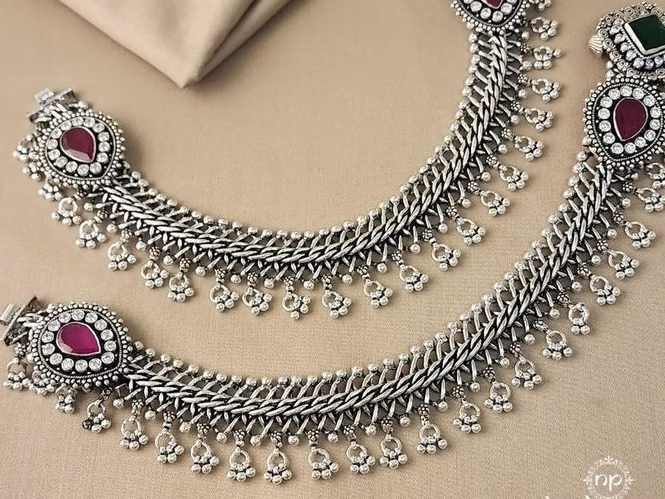
🌟 Materials Used in Filigree Anklets
The charm of filigree anklets comes largely from the careful selection of materials. Every element contributes to the strength, shine, and finesse of the final piece.
Let’s explore the materials that make them shine and the meticulous steps behind creating each anklet.
- Silver
- Traditionally, filigree work is done in pure or sterling silver.
- Silver is lightweight, easy to mold, and gives a bright, lustrous finish.
- It’s perfect for contemporary ethnic fashion because it balances elegance and everyday wearability.
- Traditionally, filigree work is done in pure or sterling silver.
- Gold (Occasionally)
- Some modern anklets use gold or gold-plated silver to add luxury.
- Gold highlights the delicate motifs, making the anklet suitable for weddings or festive occasions.
- Some modern anklets use gold or gold-plated silver to add luxury.
- Fine Wires
- Extremely thin silver or gold wires form the backbone of filigree work.
- These wires are twisted, curled, and soldered to create intricate patterns like flowers, leaves, or geometric shapes.
- Extremely thin silver or gold wires form the backbone of filigree work.
- Beads and Stones
- Small pearls, gemstones, or colored beads are sometimes added to enhance the aesthetic.
- These elements bring a subtle pop of color, keeping the design playful yet traditional.
- Small pearls, gemstones, or colored beads are sometimes added to enhance the aesthetic.
- Hooks and Clasps
- Modern anklets include sturdy hooks or adjustable chains for convenience.
- These ensure the anklet fits comfortably without compromising the delicate design.
- Modern anklets include sturdy hooks or adjustable chains for convenience.
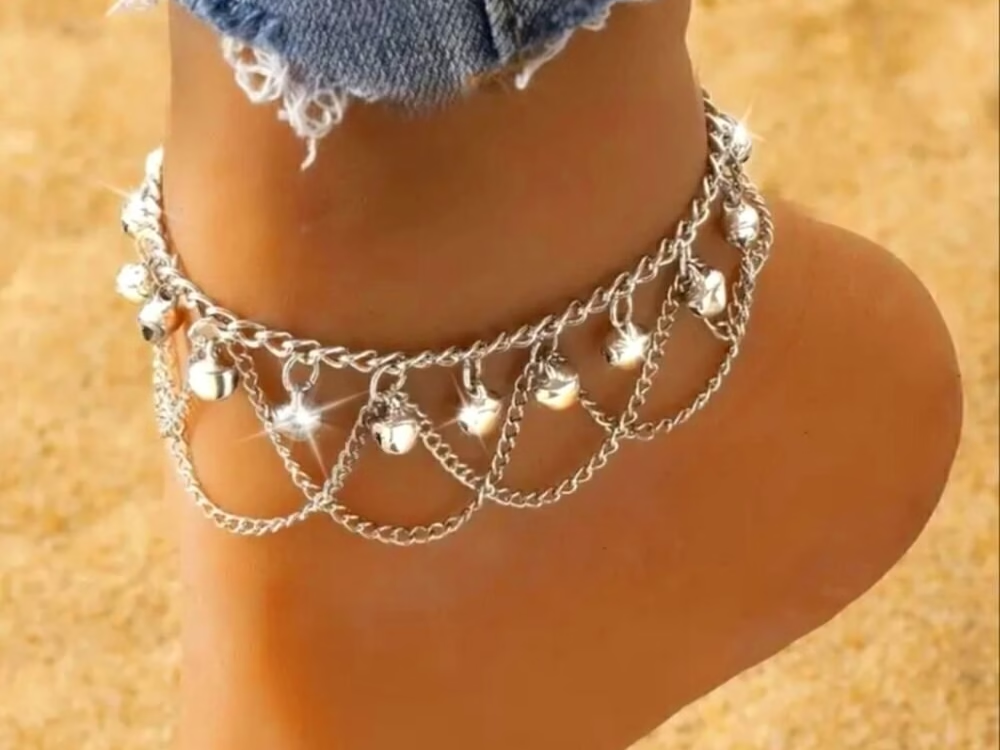
🛠 Steps of Making Filigree Anklets
Creating a filigree anklet is a labor of patience, skill, and precision. Artisans spend hours crafting each piece, and the process has remained largely traditional, even in modern adaptations.
1. Designing the Anklet
- The process starts with a rough sketch or blueprint.
- Designers plan the pattern, size, and placement of decorative elements like beads or motifs.
- Every curve and swirl is visualized before any wire is touched.
2. Selecting and Preparing the Wire
- Thin silver or gold wires are chosen according to the design.
- Wires are cleaned, straightened, and cut into precise lengths.
- The flexibility and smoothness of the wire are critical for intricate work.
3. Twisting and Shaping the Wires
- Wires are twisted, coiled, and bent using fine tools.
- Tiny pliers help create spirals, loops, and curls.
- These shapes form flowers, leaves, or traditional patterns characteristic of filigree art.
4. Soldering the Pieces Together
- Individual wire elements are carefully joined using soldering techniques.
- Soldering requires steady hands because the wires are extremely delicate.
- This step gives structural strength while keeping the intricate design intact.
5. Adding Beads and Stones (Optional)
- If the design includes pearls or gemstones, they are attached at this stage.
- Artisans ensure that each embellishment complements the overall filigree pattern.
6. Shaping the Anklet Base
- Once the decorative elements are ready, they are mounted onto a circular anklet base.
- The base provides stability while allowing flexibility for comfortable wear.
7. Polishing and Finishing
- The finished anklet is polished to bring out the shine of the metal.
- Any rough edges are smoothed, ensuring the piece is both beautiful and safe to wear.
8. Quality Check
- Every anklet is inspected for symmetry, durability, and design accuracy.
- Only flawless pieces make it to the market, ensuring that modern wearers get a perfect blend of tradition and contemporary style.
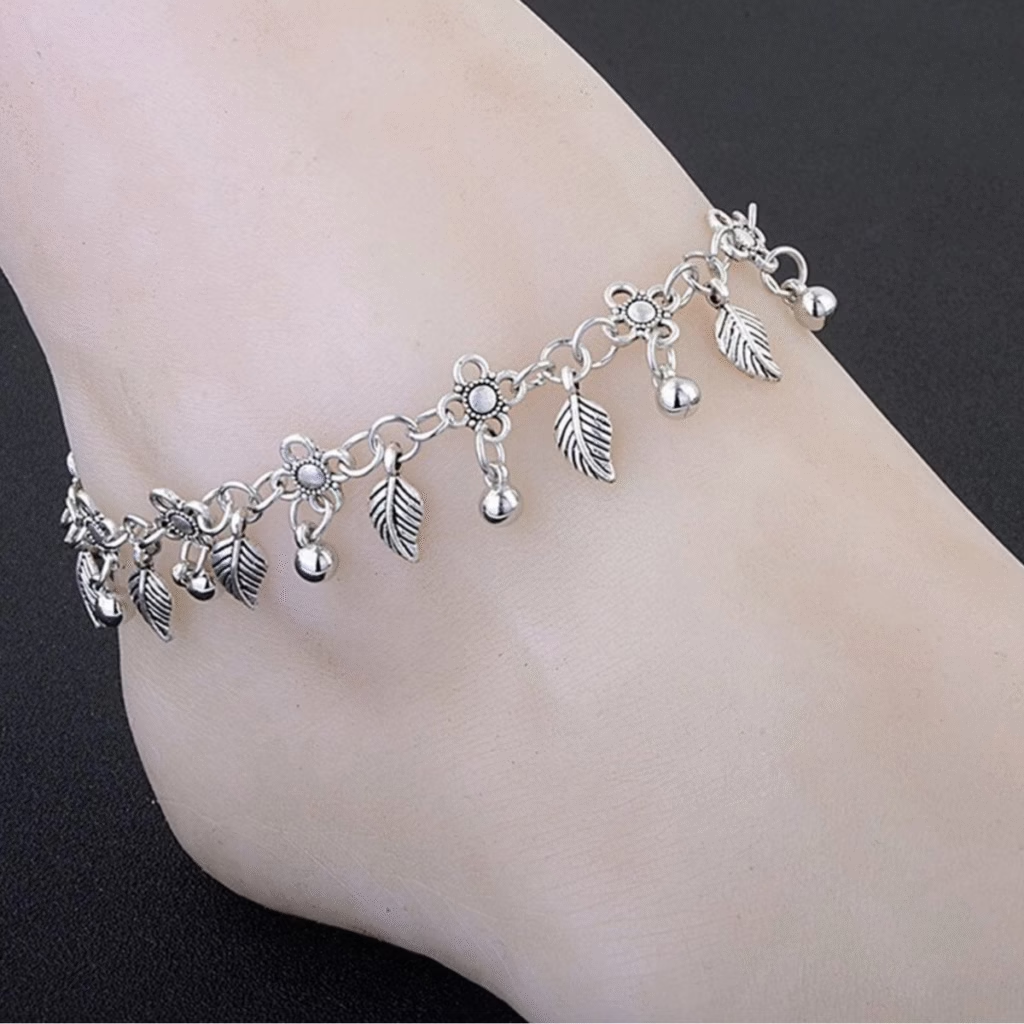
Symbols and Motifs in Filigree Anklets
Filigree anklets are more than just pieces of jewelry—they are tiny works of art that tell stories. Each curve, twist, and motif carries meaning passed down through generations.
When worn with contemporary ethnic fashion, these anklets don’t just add sparkle—they add culture, symbolism, and personality. Let’s explore the fascinating symbols and motifs often seen in filigree anklets.
1. Floral Motifs: Nature’s Beauty in Metal
- Lotus Flowers
- One of the most common motifs in filigree jewelry.
- Symbolizes purity, growth, and enlightenment.
- On anklets, lotus designs add a delicate, feminine touch to both traditional and modern outfits.
- One of the most common motifs in filigree jewelry.
- Petals and Vines
- Small, flowing petal patterns and intertwining vines often form the chains or the danglers of anklets.
- Represent life, growth, and continuity.
- Perfect for pairing with flowy skirts or ethnic dresses.
- Small, flowing petal patterns and intertwining vines often form the chains or the danglers of anklets.
- Sunflowers and Other Blooms
- Cheerful and vibrant designs convey positivity and energy.
- These motifs make anklets stand out even with minimal attire.
- Cheerful and vibrant designs convey positivity and energy.
2. Geometric Patterns: Order and Elegance
- Circles and Spirals
- Represent eternity, wholeness, and cyclical life.
- On anklets, spirals often form small dangling charms that move with every step, creating subtle visual rhythm.
- Represent eternity, wholeness, and cyclical life.
- Triangles and Diamonds
- Symbolize balance, stability, and protection.
- Diamonds are also considered auspicious in many traditional designs.
- Symbolize balance, stability, and protection.
- Checks and Grids
- Sometimes the anklet bands themselves have finely etched grid-like patterns.
- Adds a modern geometric twist to a traditional art form, making it perfect for fusion wear.
- Sometimes the anklet bands themselves have finely etched grid-like patterns.
3. Animal and Bird Motifs: Energy and Spirit
- Elephants
- Represent strength, wisdom, and good luck.
- Tiny elephant charms or etchings in anklets can bring an auspicious vibe to everyday wear.
- Represent strength, wisdom, and good luck.
- Peacocks
- Symbolize beauty, pride, and grace.
- Peacock feather designs or mini peacock figures are often used in danglers, adding a festive and ethnic touch.
- Symbolize beauty, pride, and grace.
- Parrots and Other Birds
- Birds indicate freedom and joy.
- When paired with ethnic sandals, these anklets tell a lively, spirited story with every step.
- Birds indicate freedom and joy.
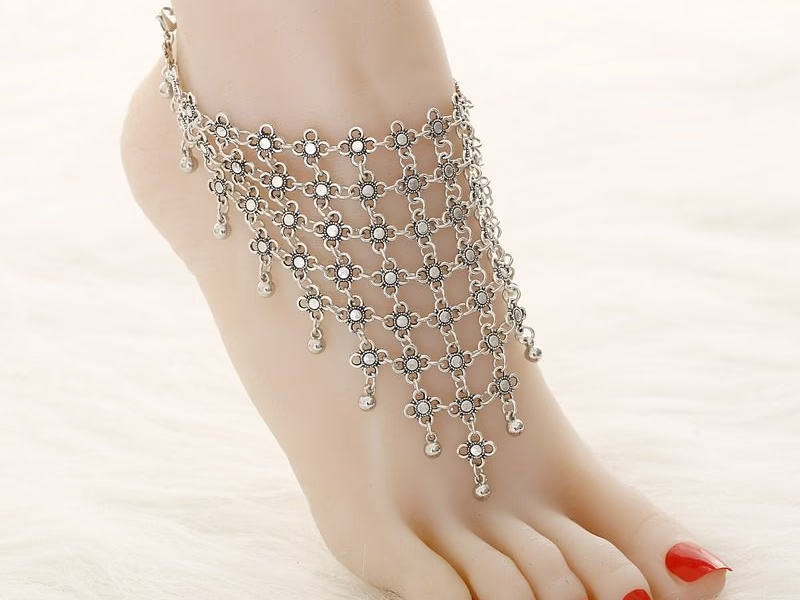
4. Spiritual and Cultural Symbols
- Sun and Moon Motifs
- Represent balance, energy, and positivity.
- Sun motifs are often engraved on the anklet base, while moon motifs may appear as dangling charms.
- Represent balance, energy, and positivity.
- Conch Shells and Bells
- Symbolize auspicious beginnings and are believed to ward off negative energy.
- Miniature bells add both sound and symbolic charm, creating rhythmic jingles with each step.
- Symbolize auspicious beginnings and are believed to ward off negative energy.
- Paisley (Mango) Patterns
- A classic motif in Indian art and jewelry.
- Symbolizes fertility, growth, and beauty.
- Often carved or etched along the anklet chain to add intricate detail.
- A classic motif in Indian art and jewelry.
5. Modern Interpretations and Fusion Motifs
- Abstract Curves and Minimalist Lines
- Designers today mix traditional filigree with abstract motifs to appeal to modern tastes.
- Subtle twists, asymmetrical shapes, and clean lines blend heritage with contemporary fashion.
- Designers today mix traditional filigree with abstract motifs to appeal to modern tastes.
- Customized Symbols
- Some contemporary anklets feature initials, hearts, or zodiac-inspired charms.
- They make the piece personal and unique, perfect for gifting.
- Some contemporary anklets feature initials, hearts, or zodiac-inspired charms.
- Fusion of Nature and Geometry
- Combining floral, animal, and geometric patterns is a popular trend.
- These hybrid motifs make the anklets versatile for ethnic wear, casual dresses, or even fusion outfits
- Combining floral, animal, and geometric patterns is a popular trend.
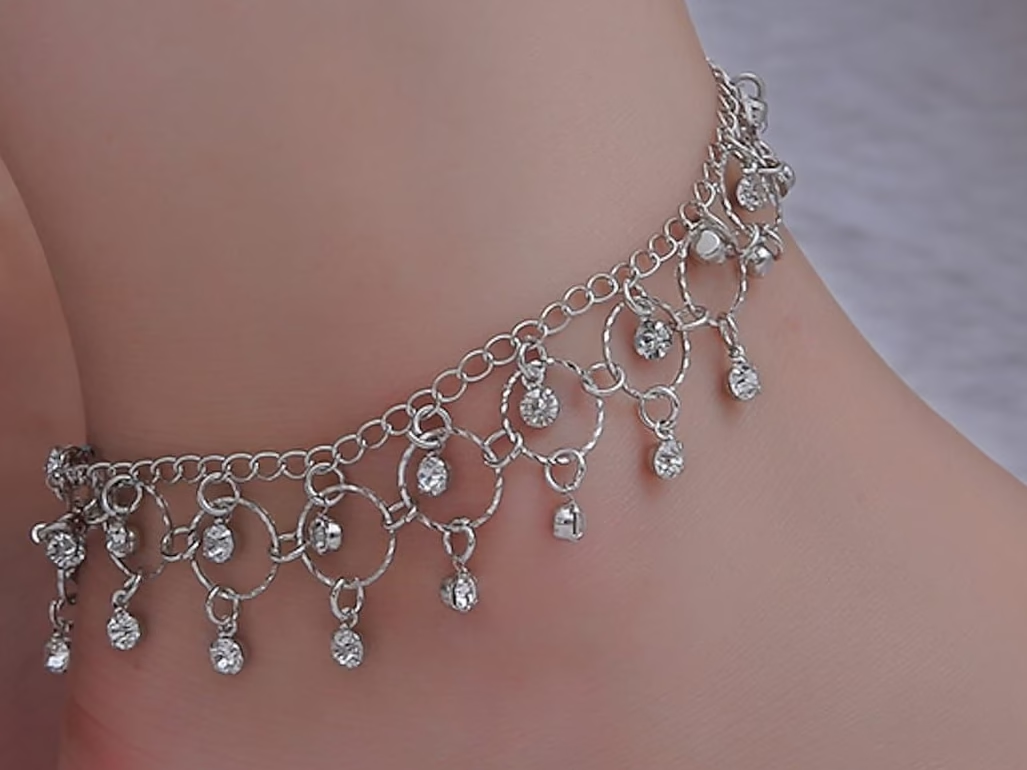
Statistics: Filigree Anklets for Contemporary Ethnic Fashion
Filigree anklets are not just pieces of jewelry; they are a blending of heritage and style. Let’s explore the statistics that show why filigree anklets are becoming a staple in contemporary ethnic fashion.
📈 Growing Popularity of Filigree Jewelry
- Rising Demand: Over the last decade, the demand for traditional Indian jewelry, especially filigree designs, has increased by 25–30% annually in urban markets.
- Global Interest: Countries like the USA, UK, and UAE have seen a 15% rise in imports of Indian handcrafted jewelry since 2018.
- Ethnic Fusion Trend: Around 60% of young women aged 20–35 in India prefer ethnic-inspired accessories for casual and festive wear, including anklets.
💍 Filigree Anklets in the Indian Market
- Market Share: Filigree anklets account for about 12% of the traditional anklet market in India, showing consistent growth year-on-year.
- Urban vs Rural: Urban buyers contribute nearly 70% of filigree jewelry sales, while rural markets are slowly adopting them due to online accessibility.
- Festival and Wedding Sales: Sales spike during weddings and festivals, contributing to 40–50% of annual revenue for handcrafted jewelry brands.
🌍 International Reach
- Exports: Filigree jewelry exports from India have increased by 20% annually over the past five years.
- Popular Destinations: The USA, UK, Australia, and the Middle East lead as top buyers of traditional filigree anklets.
- Online Growth: With platforms like Etsy, Amazon, and dedicated Indian handicraft sites, online purchases account for 35% of international sales.
🎯 Demographics and Consumer Insights
- Age Group: The highest consumers of filigree anklets are women aged 20–35, especially students, young professionals, and wedding shoppers.
- Preference Patterns: Around 55% prefer lightweight designs, while 45% opt for elaborate, traditional anklets.
- Fashion Conscious Buyers: Millennials and Gen Z are combining filigree anklets with Western ethnic fusion outfits, increasing cross-over purchases.
🛍️ Online and Offline Trends
- E-commerce Boost: Online sales of filigree anklets have grown by 30% year-on-year in India due to fashion bloggers and social media influence.
- Retail Presence: Traditional jewelry stores see steady demand, with festival seasons bringing a 50–60% spike in footfall for handcrafted anklets.
- Price Range: Filigree anklets typically range from INR 800 to INR 8,000, catering to both budget and luxury segments.
🌿 Sustainable and Handcrafted Appeal
- Eco-conscious Buyers: Nearly 40% of buyers prefer filigree anklets because they are handcrafted using eco-friendly methods.
- Cultural Appreciation: Consumers also value the cultural heritage, with 30% explicitly mentioning handmade design as a key purchase factor.
- Gifting Trends: Filigree anklets are popular gifts, accounting for 20% of total sales during Diwali, Raksha Bandhan, and wedding seasons.
The Wrap-Up Lines
Well, folks, you can look at filigree anklets as more than just jewelry—they’re a stunning blend of history, culture, and pure craftsmanship.
These delicate pieces, with their intricate hand-woven metal threads, literally carry the stories of artistry passed down through generations. What’s amazing is how they’ve totally embraced modern ethnic fashion.
You can pair them with a traditional saree or a contemporary Indo-western outfit; they just add a unique spark and timeless elegance to any look. They’re basically a wearable piece of heritage that still fits perfectly in today’s fashion world!
Also Read:- Dokra-Inspired Mobile Charms

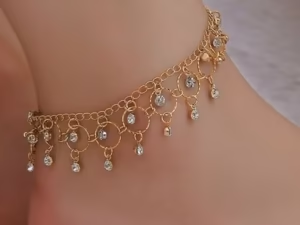
Leave a Reply